by Jon LeSage, editor and publisher, Green Auto Market
Here’s my take on the 10 most significant and interesting occurrences during the past week…….
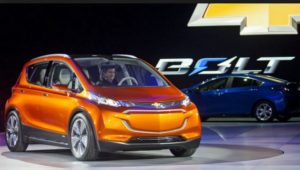 Bolt launch: The Chevy Bolt is back on track to launch by the end of the year, and it had never gone off course, according to Chevrolet. Several media reports and enthusiast websites said that the Bolt would be delayed by six months. The Bolt remains on schedule, with U.S. sales set to begin by year end, according to a Chevrolet spokesman. General Motors engineers have been spotted testing Bolts equipped with correct finishes and colors in the Detroit area, which means that the Bolt is on schedule.
Bolt launch: The Chevy Bolt is back on track to launch by the end of the year, and it had never gone off course, according to Chevrolet. Several media reports and enthusiast websites said that the Bolt would be delayed by six months. The Bolt remains on schedule, with U.S. sales set to begin by year end, according to a Chevrolet spokesman. General Motors engineers have been spotted testing Bolts equipped with correct finishes and colors in the Detroit area, which means that the Bolt is on schedule.- Midterm review extension: Three Congressional leaders asked federal environmental and safety officials to extend by 60 days the public comment period for the midterm review on new vehicle emissions and fuel economy standards. Fred Upton, chairman of the Committee on Energy and Commerce; Ed Whitfield, chairman of the Subcommittee on Energy and Power; and Michael Burgess, chairman of the Subcommittee on Commerce, Manufacturing and Trade, signed the letter that was sent to EPA Administrator Gina McCarthy and National Highway Traffic Safety Administration Administrator Mark Rosekind.
- Audi electrified: Audi is preparing sporty models and electrified vehicles for launch as it emerges from parent company’s diesel reporting scandal. Audi has committed to make sure 25% of its sales will be plug-in hybrid or battery electric vehicles by 2025. Audi said the e-tron Quattro all-electric crossover vehicle will go on sale in 2018 as the lead model in its electrified vehicle campaign, with U.S. sales expected to start in 2019.
- California bill on HOV stickers: Plug In America has been opposing a bill in the California legislature, Assembly Bill 1964, that supports plug-in hybrids but limits purchase incentives on battery electric vehicles. The electric car advocacy group appreciates support the bill gives to High-Occupancy Vehicle (HOV) carpool lane green stickers for plug-in hybrid vehicles, but opposes limitations placed on white stickers for battery electric vehicles. As of last night, the bill had not progressed through the voting procedure in Sacramento and is likely to be put on hold.
- AB 1613: CALSTART is supporting California Assembly Bill 1613, which is backed by President pro Tempore Kevin De León and would allocate approximately $1.2 billion in revenues collected under the state’s cap and trade program. The majority of the funds were generated during auctions held by the state in 2015. “If Assembly Bill 1613 is approved by both houses, it would enable approximately $20 million in high-value clean transportation projects in the San Joaquin Valley. A number of very promising and different electric trucks and buses would be deployed in the Valley if this legislation passes,” said CALSTART President and CEO John Boesel. Read all about the clean transportation projects being funded that include electric transit buses and postal trucks.
- Fuel cell military pickup: General Motors will be testing out a hydrogen-powered Chevy Colorado pickup with the U.S. Army Tank Automotive Research Development and Engineering Center (TARDEC) for military use. TARDEC says that it appreciates fuel cell capability because of its capabilities in off-road environments and because it is quiet. Additional tests will include demonstrating exportable power generation. GM and TARDEC will showcase the fuel cell vehicle at the Association of the United States Army’s fall meeting.
- Uber takes a loss: Uber lost $1.27 billion in the first half of 2016, according to sourves attending a shareholder call recently for the privately-held company. Incentive subsidies paid to Uber drivers, especially in China, caused much of the loss, the Uber chief financial officer said during the call. Subsidies for Uber’s drivers are responsible for the majority of the company’s losses globally, Gupta said during the earnings call. Some of that loss has come through intense competition with Chinese ride-hailing market leader Didi Chuxing. Uber has lost about $2 billion in two years in China, and has invested at least $1 billion in subsidy incentives for drivers in that market, according to the Bloomberg report. The recent deal with Chinese ride-hailing giant Didi is expected to help stabilize Uber’s financials. Another challenge has come through an aggressive price war with Lyft.
- Startups getting hit in China: Starting up an electric vehicle manufacturing company has been a hot commodity for angel investors in China, including well-known technology business leaders. That’s expected to take a downward spiral as the government leans toward cutting the list down to only 10 startups that will be receiving permits to become vehicle manufacturers. Half of those spots might already be taken. Beijing Electric Vehicle Co. and Hangzhou Changjiang Passenger Vehicle Co. have been grated permits. Companies preparing to file include Wanxiang Group, LeEco, and WM Motor.
- Kia Optima PHEV: Car and Driver reviewed the Optima PHEV (plug-in hybrid electric vehicle), Kia’s first plug-in. The main difference from the regular Optima hybrid lurks under the rear seats and trunk floor: a 9.8-kWh lithium-ion battery pack that, Kia claims, allows the PHEV to go up to 29 miles in electric-only mode and to operate at speeds of up to 75 mph on battery and electric motor, according to the reviewer.
- Cap and trade funds: See where funds raised by California’s cap and trade auction end up. It’s called the Greenhouse Gas Reduction Fund and has committed $850 to the state’s high-speed rail project as its largest recipient. Low carbon transportation projects are receiving $325 million to back zero and near-zero emission passenger vehicle rebates, freight transportation projects, and others.

 California has settled a legislative battle through simultaneous passage of Senate Bill 32 and Assembly Bill 197 – or at least has gained a temporary truce. SB 32 extends the state’s greenhouse gas mandate another 10 years and reduces greenhouse gases even more. AB 197 expands oversight of the California Air Resources Board with a priority set on cutting emissions from local oil refineries and manufacturers. The two bills were “double-joined,” which is legislative jargon meaning both bills have to be signed into law by Gov. Jerry Brown to take effect. That signature is expected to be happening soon. Brown had already filed an executive order with similar goals, but the legislation once signed turns it into law.
California has settled a legislative battle through simultaneous passage of Senate Bill 32 and Assembly Bill 197 – or at least has gained a temporary truce. SB 32 extends the state’s greenhouse gas mandate another 10 years and reduces greenhouse gases even more. AB 197 expands oversight of the California Air Resources Board with a priority set on cutting emissions from local oil refineries and manufacturers. The two bills were “double-joined,” which is legislative jargon meaning both bills have to be signed into law by Gov. Jerry Brown to take effect. That signature is expected to be happening soon. Brown had already filed an executive order with similar goals, but the legislation once signed turns it into law.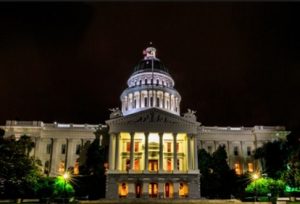 California climate change bill: Legislation extending California’s climate change law through 2030 narrowly passed in the Assembly,
California climate change bill: Legislation extending California’s climate change law through 2030 narrowly passed in the Assembly, 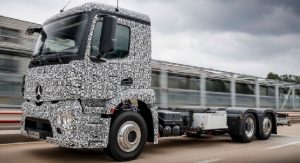 Commercial electric vehicles are seeing a revival this year, encouraged by government incentives and demand coming from fleets and freight haulers. Electric truckmakers and suppliers had seen several financial failures in recent years, but a turnaround is starting to pick up. California is playing a leading role, with its Sustainable Freight Action Plan aiming to see 100,000 trucks, trains, and cargo-moving machines fueled by cleaner fuels or electricity through its ports and on its roads by 2030. For the global market, Navigant Research says sales of electric drive and electric-assisted commercial vehicles are expected to grow from less than 16,000 in 2014 to nearly 160,000 in 2023. Electric hybrid vehicles are now being used in commercial applications where the improved technology offers major benefits for specific drive cycles that involve city driving in stop-start traffic, Navigant says.
Commercial electric vehicles are seeing a revival this year, encouraged by government incentives and demand coming from fleets and freight haulers. Electric truckmakers and suppliers had seen several financial failures in recent years, but a turnaround is starting to pick up. California is playing a leading role, with its Sustainable Freight Action Plan aiming to see 100,000 trucks, trains, and cargo-moving machines fueled by cleaner fuels or electricity through its ports and on its roads by 2030. For the global market, Navigant Research says sales of electric drive and electric-assisted commercial vehicles are expected to grow from less than 16,000 in 2014 to nearly 160,000 in 2023. Electric hybrid vehicles are now being used in commercial applications where the improved technology offers major benefits for specific drive cycles that involve city driving in stop-start traffic, Navigant says.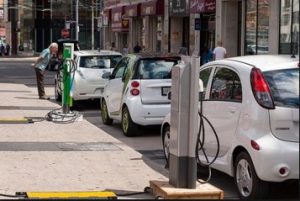 Support for nationwide network: The Obama administration is adding to its support for
Support for nationwide network: The Obama administration is adding to its support for 
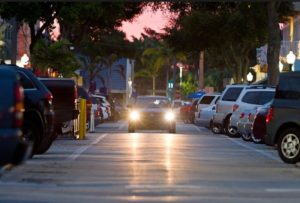 In the not-too distant future, parking cars in crowded cities is expected to improve drastically. Self-driving cars will drop off riders and take care of the parking. Automated parking systems (APS) are starting to provide parking for cars on multiple levels stacked vertically to maximize the number of parking spaces while minimizing land usage.
In the not-too distant future, parking cars in crowded cities is expected to improve drastically. Self-driving cars will drop off riders and take care of the parking. Automated parking systems (APS) are starting to provide parking for cars on multiple levels stacked vertically to maximize the number of parking spaces while minimizing land usage. ZEV credits tightening:
ZEV credits tightening: 
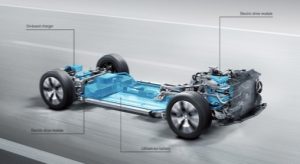 Daimler green powertrain plan: Daimler will be
Daimler green powertrain plan: Daimler will be 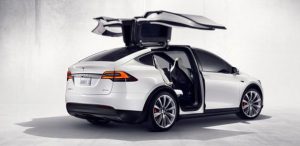 May EV and hybrid sales: The Tesla Model X has seen a huge sales increase – up a third from the previous month. Consumer Reports did feature a critical review in print and video, focused mainly on concerns with the falcon doors and too many bells and whistles versus practical features. That was released last week, so we’ll have to check on June sales to see if it’s having an impact. The Model S is seeing some decline in sales month-over-month and year-over-year. The Ford Fusion Energi is doing well in sales, and is getting closer to the Fusion Hybrid in overall sales numbers. The Ford C-Max Energi continues to soften in sales. Overall battery electric and plug-in hybrid electric vehicle sales were flat from April, and were up 5.5% over May 2015. Hybrid sales as a share of total U.S. new vehicle sales increased slightly – up to 2% of the total share after it had been hovering below the 2% mark for several months. Since it was debuted in January 2015, the Toyota RAV4 Hybrid has become a hot seller. Now at No. 2 in the rankings, it came in at No. 9 during the month of December 2015 with 1,430 units sold that month. The hybrid version was debuted a few months after Toyota halted production of the low-selling all-electric RAV4.
May EV and hybrid sales: The Tesla Model X has seen a huge sales increase – up a third from the previous month. Consumer Reports did feature a critical review in print and video, focused mainly on concerns with the falcon doors and too many bells and whistles versus practical features. That was released last week, so we’ll have to check on June sales to see if it’s having an impact. The Model S is seeing some decline in sales month-over-month and year-over-year. The Ford Fusion Energi is doing well in sales, and is getting closer to the Fusion Hybrid in overall sales numbers. The Ford C-Max Energi continues to soften in sales. Overall battery electric and plug-in hybrid electric vehicle sales were flat from April, and were up 5.5% over May 2015. Hybrid sales as a share of total U.S. new vehicle sales increased slightly – up to 2% of the total share after it had been hovering below the 2% mark for several months. Since it was debuted in January 2015, the Toyota RAV4 Hybrid has become a hot seller. Now at No. 2 in the rankings, it came in at No. 9 during the month of December 2015 with 1,430 units sold that month. The hybrid version was debuted a few months after Toyota halted production of the low-selling all-electric RAV4.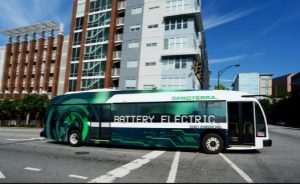 US-China electric bus competition: On Friday in Los Angeles, U.S. Secretary of Transportation Anthony Foxx and Chinese Minister of Transport Yang Chuantang signed an agreement officially announcing the US-China “Race to Zero Emissions.” One city from each of the two countries will be competing to determine which one will deploy the highest percentage of emission free buses by 2025. The race is designed to improve air quality in urban areas and prevent climate change. For each of the cities entering the competition, the minimum size of the fleet must be 200 or more buses. Two smaller transit properties can form a team and compete in the race if their combined fleet size is 200 buses or more. Potential participants can learn more at
US-China electric bus competition: On Friday in Los Angeles, U.S. Secretary of Transportation Anthony Foxx and Chinese Minister of Transport Yang Chuantang signed an agreement officially announcing the US-China “Race to Zero Emissions.” One city from each of the two countries will be competing to determine which one will deploy the highest percentage of emission free buses by 2025. The race is designed to improve air quality in urban areas and prevent climate change. For each of the cities entering the competition, the minimum size of the fleet must be 200 or more buses. Two smaller transit properties can form a team and compete in the race if their combined fleet size is 200 buses or more. Potential participants can learn more at